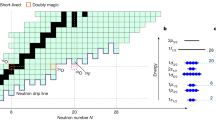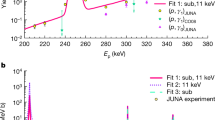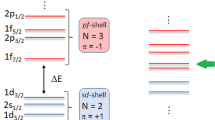Abstract
Carbon burning powers scenarios that influence the fate of stars, such as the late evolutionary stages of massive stars1 (exceeding eight solar masses) and superbursts from accreting neutron stars2,3. It proceeds through the 12C + 12C fusion reactions that produce an alpha particle and neon-20 or a proton and sodium-23—that is, 12C(12C, α)20Ne and 12C(12C, p)23Na—at temperatures greater than 0.4 × 109 kelvin, corresponding to astrophysical energies exceeding a megaelectronvolt, at which such nuclear reactions are more likely to occur in stars. The cross-sections4 for those carbon fusion reactions (probabilities that are required to calculate the rate of the reactions) have hitherto not been measured at the Gamow peaks4 below 2 megaelectronvolts because of exponential suppression arising from the Coulomb barrier. The reference rate5 at temperatures below 1.2 × 109 kelvin relies on extrapolations that ignore the effects of possible low-lying resonances. Here we report the measurement of the 12C(12C, α0,1)20Ne and 12C(12C, p0,1)23Na reaction rates (where the subscripts 0 and 1 stand for the ground and first excited states of 20Ne and 23Na, respectively) at centre-of-mass energies from 2.7 to 0.8 megaelectronvolts using the Trojan Horse method6,7 and the deuteron in 14N. The cross-sections deduced exhibit several resonances that are responsible for very large increases of the reaction rate at relevant temperatures. In particular, around 5 × 108 kelvin, the reaction rate is boosted to more than 25 times larger than the reference value5. This finding may have implications such as lowering the temperatures and densities8 required for the ignition of carbon burning in massive stars and decreasing the superburst ignition depth in accreting neutron stars to reconcile observations with theoretical models3.
This is a preview of subscription content, access via your institution
Access options
Access Nature and 54 other Nature Portfolio journals
Get Nature+, our best-value online-access subscription
$29.99 / 30 days
cancel any time
Subscribe to this journal
Receive 51 print issues and online access
$199.00 per year
only $3.90 per issue
Buy this article
- Purchase on Springer Link
- Instant access to full article PDF
Prices may be subject to local taxes which are calculated during checkout



Similar content being viewed by others
Change history
28 June 2018
In equation (1) of this Letter, the closing bracket was missing; in Extended Data Fig. 1 and the accompanying legend, ‘Φ(pd)’ should have been ‘Φ2(pd)’, and in the Methods the text “Odd J assignments are uncertain by ±1.” has been added. These errors have all been corrected online.
References
Woosley, S. E., Heger, A. & Weaver, T. A. The evolution and explosion of massive stars. Rev. Mod. Phys. 74, 1015–1071 (2002).
Keek, L. et al. First superburst from a classical low-mass X-ray binary transient. Astron. Astrophys. 479, 177–188 (2008).
Cooper, R. L. et al. Possible resonances in the 12C + 12C fusion rate and superburst ignition. Astrophys. J. 702, 660–671 (2009).
Iliadis, C. Nuclear Physics of Stars. (Wiley, Weinheim, 2007).
Caughlan, G. R. & Fowler, W. A. Thermonuclear reaction rates V. At. Data Nucl. Data Tables 40, 283–334 (1988).
Spitaleri, C. et al. The Trojan Horse Method in nuclear astrophysics. Phys. At. Nucl. 74, 1725–1739 (2011).
Tribble, R. et al. Indirect techniques in nuclear astrophysics: a review. Rep. Prog. Phys. 77, 106901–106950 (2014).
Pignatari, M. et al. The 12C + 12C reaction and the impact on nucleosynthesis in massive stars. Astrophys. J. 762, 31–54 (2013).
Abegg, R. & Davis, C. A. 12Mg states observed via 20Ne(α,α0)20Ne. Phys. Rev. C 43, 2523–2540 (1991).
Itoh, K. et al. Electroexcitation of giant multipole resonances in 24Mg. Phys. Rev. C 23, 945–959 (1981).
Yang, G. C. et al. Isoscalar multipole strength in 24Mg through inelastic α scattering. Phys. Rev. C 13, 1376–1387 (1976).
Vanhoy, J. R. et al. Proton resonances in 24Mg from E x = 12.7 to 15.7 MeV. Phys. Rev. C 36, 920–932 (1987).
Bertrand, F. E. et al. Giant quadrupole resonance in 24,26Mg: a comparison of inelastic-scattering and α-capture experiments. Phys. Rev. Lett. 40, 635–638 (1978).
Becker, H. W., Kettner, K. U., Rolfs, C. & Trautvetter, H. P. The 12C + 12C reaction at sub-Coulomb energies (II). Z. Phys. A 303, 305–312 (1981).
Spillane, T. et al. 12C + 12C fusion reactions near the Gamow Energy. Phys. Rev. Lett. 98, 122501–122505 (2007).
Lane, A. M. & Thomas, R. G. R-matrix theory of nuclear reactions. Rev. Mod. Phys. 30, 257–353 (1958).
Aguilera, E. F. et al. New γ-ray measurements for 12C + 12C sub-Coulomb fusion: toward data unification. Phys. Rev. C 73, 064601–064612 (2006).
Mazarakis, M. G. & Stephens, W. E. Experimental measurements of the 12C + 12C nuclear reactions at low energies. Phys. Rev. C 7, 1280–1287 (1973).
High, M. D. & Cujec, B. The 12C + 12C sub-Coulomb fusion cross section. Nucl. Phys. A 282, 181–188 (1977).
Kettner, K. U., Lorenz-Wirzba, H. & Rolfs, C. The 12C + 12C reaction at subcoulomb energies. Z. Phys. A 298, 65–75 (1980).
Barrón-Palos, L. et al. Absolute cross sections measurement for the 12C + 12C system at astrophysically relevant energies. Nucl. Phys. A 779, 318–332 (2006).
Caciolli, A. et al. Proton elastic scattering and proton induced γ-ray emission cross-sections on 23Na from 2 to 5 MeV. Nucl. Instrum. Meth. Phys. Res. B 266, 1392–1396 (2008).
Zickefoose, J. 12C + 12C Fusion: Measurement and Advances Toward the Gamow Energy. PhD thesis, Univ. of Connecticut (2011); https://pqdtopen.proquest.com/doc/908637546.html?FMT=AI.
Jiang, C. L. et al. Reaction rate for carbon burning in massive stars. Phys. Rev. C 97, 012801–012806 (2018).
Thielemann, F.-K., Arnould, M. & Truran, J. W. Thermonuclear reactions rate from statistical model calculations. In Advances in Nuclear Astrophysics (2nd IAP Workshop) (ed. Vangioni-Flam, E.) 525 (Les Editions Frontières, Gif sur Yvette, 1987).
Schatz, H. et al. Strong neutrino cooling by cycles of electron capture and β - decay in neutron star crust. Nature 505, 62–65 (2014).
Bravo, E. et al. Type Ia supernovae and the 12C + 12C reaction rate. Astron. Astrophys. 535, A114 (2011).
Straniero, O., Piersanti, L. & Cristallo, S. Do we really know Mup (i.e. the transition mass between type Ia and core-collapse supernova progenitors)? J. Phys. Conf. Ser. 665, 012008 (2016).
Strieder, F., Rolfs, C., Spitaleri, C. & Corvisiero, P. Electron-screening effects on fusion reactions. Naturwissenschaften 88, 461–467 (2001).
Spitaleri, C. et al. Indirect 7Li(p,α)4He reaction at astrophysical energies. Phys. Rev. C 60, 055802–055809 (1999).
Lamia, L. et al. An updated 6Li(p,α)3He reaction rate at astrophysical energies with the Trojan horse method. Astrophys. J. 768, 65–73 (2013).
Tumino, A. et al. New determination of the 2H(d,p)3H and 2H(d,n)3He reaction rates at astrophysical energies. Astrophys. J. 785, 96–113 (2014).
Pizzone, R. G. et al. First measurement of the 19F(α,p)22Ne reaction at energies of astrophysical relevance. Astrophys. J. 836, 57–63 (2017).
Spitaleri, C. et al. Measurement of the 10B(p,α 0)7Be cross section from 5 keV to 1.5 MeV in a single experiment using the Trojan horse method. Phys. Rev. C 95, 035801–035814 (2017).
Mukhamedzhanov, A. M. et al. Trojan Horse as an indirect technique in nuclear astrophysics. Resonance reactions. J. Phys. G 35, 014016–014022 (2008).
La Cognata, M. et al. On the measurement of the 13C(α,n)16O S-factor at negative energies and its influence on the s-process. Astrophys. J. 777, 143–164 (2013).
La Cognata, M. et al. Effect of high-energy resonances on the 18O(p, α)15N reaction rate at AGB and post-AGB relevant temperatures. Astrophys. J. 723, 1512–1522 (2010).
Mukhamedzhanov, A. M. et al. Theory of deuteron stripping. From surface integrals to generalized R-matrix approach. Phys. Rev. C 84, 044616–044622 (2011).
La Cognata, M. et al. The fluorine destruction in stars: first experimental study of the 19F(p,α0)16O reaction at astrophysical energies. Astrophys. J. 739, L54–L60 (2011).
Zurmühle, R. W. et al. Observation of 12C cluster transfer by angular correlation measurements. Phys. Rev. C 49, 2549–2554 (1994).
Belyaeva, T. L., Zelenskaya, N. S. & Aguero Granados, M. Investigation of quasimolecular states in 24Mg*Mg through the analysis of the angular dα correlations in the 12C(14N,d)24Mg(α)20Ne reaction. Phys. At. Nucl. 65, 1616–1627 (2002).
Blatt, J. M. & Biedenharn, L. C. The angular distribution of scattering and reaction cross sections. Rev. Mod. Phys. 24, 258–272 (1952).
Jiang, C. L. et al. Origin and consequences of 12C + 12C fusion resonances at deep sub-barrier energies. Phys. Rev. Lett. 110, 072701–072705 (2013).
La Cognata, M. et al. A Trojan Horse approach to the production of 18F in novae. Astrophys. J. 846, 65–71 (2017).
Patterson, J. R., Winkler, H. & Zaidins, C. S. Experimental investigation of the stellar nuclear reaction 12C + 12C at low energies. Astrophys. J. 157, 367–373 (1969).
Acknowledgements
We thank V. Z. Goldberg for having inspired the idea of the experiment and for discussions and assistance. We thank A. M. Mukhamedzhanov for having developed the theoretical framework of the THM. The aid of the technical staff of INFN-LNS during the preparation of the experiment is gratefully acknowledged. We thank M. Wiescher and F. X. Timmes for comments.
Author information
Authors and Affiliations
Contributions
A.T. and C.S. proposed the experiment. A.T., C.S., M.L.C., G.L.G., I.I., L.L., R.G.P., S.M.R.P., R.S. and G.G.R. set up and ran the experiment, which lasted about one month. S.C., M.G., S.H., H.P., M.L.S., S.R. and L.T. participated in the data collection. A.T. performed the data reduction and analysis. M.L.C. developed the modified R-matrix code for the one-level many-channel case. A.T. and M.L.C. performed the statistical analysis. A.T. performed R-matrix calculations, interpreted the results, prepared the figures and wrote the manuscript. C.S. and M.L.C. contributed on the interpretation of the results. M.L.C. assisted with the figure preparation. L.L., R.G.P. and R.S. assisted with the astrophysical interpretation. A.T., C.S., M.L.C., S.C., G.L.G., I.I., L.L., R.G.P., G.G.R., R.S., S.R. and L.T. revised the manuscript.
Corresponding author
Ethics declarations
Competing interests
The authors declare no competing interests.
Additional information
Publisher’s note: Springer Nature remains neutral with regard to jurisdictional claims in published maps and institutional affiliations.
Extended data figures and tables
Extended Data Fig. 1 Deuteron momentum distribution.
The experimental distribution Φ2(pd) is shown as filled black circles. Error bars represent standard 1σ uncertainties. The black line represents the theoretical shape (see text for details).
Extended Data Fig. 2 Pole diagram describing the quasi-free mechanism in the A(a,bB)s reaction.
The upper vertex refers to the break-up of a and the lower vertex shows the A(x,b)B process. Colours help to highlight the role of individual particles in the mechanism.
Extended Data Fig. 3 Typical ∆E–E spectrum.
The strongest loci from the bottom to the top correspond to p, d and α. ADC, analogue-to-digital converter.
Extended Data Fig. 4 Q-value as a function of the α detection angle Θα for the 12C(14N,α20Ne)2H reaction.
Blue and red solid lines cross the Q-value axis at −5.65 MeV and −7.28 MeV, highlighting the contributions of the ground and first excited states, respectively.
Rights and permissions
About this article
Cite this article
Tumino, A., Spitaleri, C., La Cognata, M. et al. An increase in the 12C + 12C fusion rate from resonances at astrophysical energies. Nature 557, 687–690 (2018). https://doi.org/10.1038/s41586-018-0149-4
Received:
Accepted:
Published:
Issue Date:
DOI: https://doi.org/10.1038/s41586-018-0149-4
This article is cited by
-
Coulomb-free 1S0 p − p scattering length from the quasi-free p + d → p + p + n reaction and its relation to universality
Communications Physics (2023)
-
Production and characterisation of 20,22Ne targets
Pramana (2022)
-
Non-frozen process of heavy-ion fusion reactions at deep sub-barrier energies
Nuclear Science and Techniques (2022)
-
Progress in nuclear astrophysics of east and southeast Asia
AAPPS Bulletin (2021)
-
Revisiting the cold case of cold fusion
Nature (2019)
Comments
By submitting a comment you agree to abide by our Terms and Community Guidelines. If you find something abusive or that does not comply with our terms or guidelines please flag it as inappropriate.



